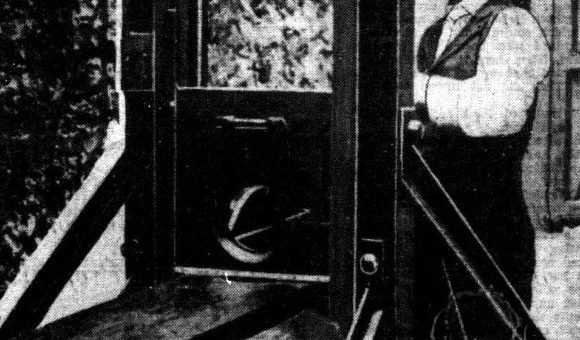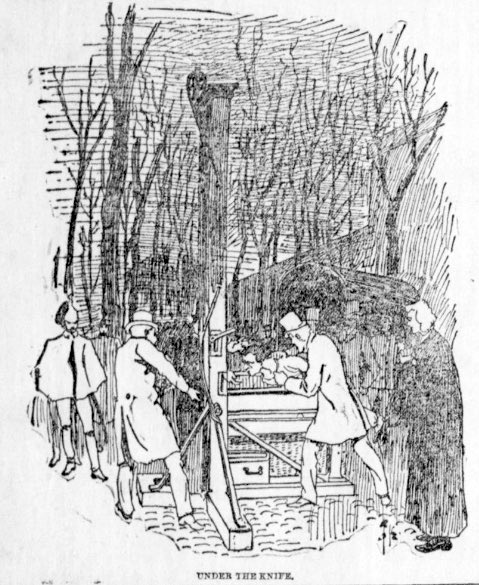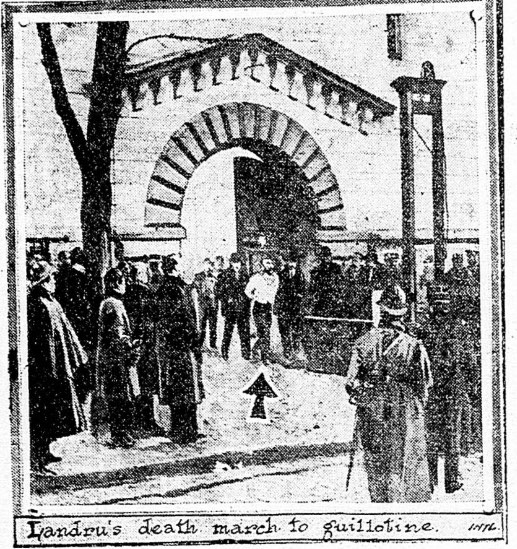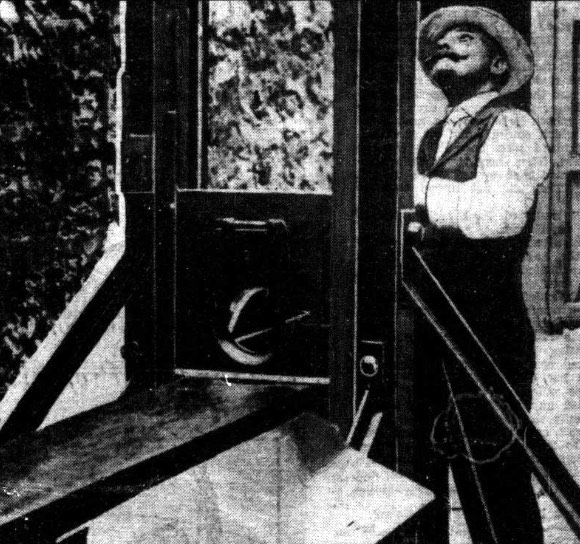
Dr. Joseph Ignace Guillotine waged a verbal war against the barbaric use of axes and swords to execute criminals, but he had very little else to do with the actual making of the guillotine. The original guillotine, called the “Louison,” was built by a German harpsichord maker, Tobias Schmitt, under the direction of a French surgeon, Dr. Antoine Louis.
France’s National Assembly voted for the use of the guillotine on March 25, 1792. A month later, it was in use. From that time, up until 1977, the “National Razor” drew crowds from across Europe to witness the executions of murderers, rapists, anarchists, and politicians. [1, 2]

1. Biting Heads
What happens to the heads after they have been lopped off by the blade of a guillotine? Normally, the heads fall into a basket lined with sawdust, but according to a report published in 1870, some decapitated heads have gone the extra mile to freak out the living.
In 1854, during an execution in Amiens, France, a woman’s head bit the lip of the catch basket and refused to let go. The executioner found her jaw muscles had tightened and by the time he got the woman’s jaws to release the basket, she had bitten a hole through the woven willow container.
During a different execution in the same city, a young man’s head totally missed the basket and rolled into the grass. When the executioner went to pick up the head, he discovered it was quite stuck to the ground. On further investigation, it was found that the decapitated head’s jaw had fastened onto a clump of grass and refused to let go. His head was pulled up with the dirt and grass still in his mouth. [3]
2. Tattoos of Premonition
The tattoos we place on our bodies have a lot to say about who we think we are. Some tattoos are humorous, some are cute, and some body markings tell a dark tale about one’s future.
Anatole Deibler, France’s most notable executioner, witnessed a number of ominous tattoos on his subjects. In an article about Deibler, published in 1932, it was said that as Deibler opened the shirts of many criminals, he saw that guillotines were often tattooed on the men’s chests.
The guillotine was usually inked in blue and given a red blade. On a few occasions, criminals had the face of Deibler himself tattooed beside the mark of the guillotine, proving that the men were fully aware that their actions would eventually take them to meet the blade.
Guillotine phrases were also popular among the criminal class. Some had the phrase, “Promised to Deibler” tattooed on the collar bone. Another common phrase was “Betrothed to the Widow.” Finally, there was “The Last Step,” which referenced the last step one took to reach the platform of the guillotine. [4]

3. Twenty Seconds, Next!
One of the main reasons why the guillotine was a popular form was execution was because it was quick. As soon as a person stepped onto the platform, he would be whisked into the guillotine and the blade would fly down. A few seconds later, the guillotine would be ready for the next victim.
One remarkable description of the swiftness of the guillotine was published in 1922. Henri Desire Landru, the “Bluebeard of Gambais,” who was accused of murdering ten women and a teenage boy, went to the guillotine.
A little after midnight on February 25th, men went to work hammering the “timbers of justice.” As the guillotine was erected, crowds started to build up outside the Versailles jail. Everyone wanted to see Landru pay for his crimes.
Everything was ready and in place by 6 am. The jail doors opened up and the prosecutor, warden, and two of Landru’s lawyers stepped out. A few minutes later, Landru was brought out. His long beard had been trimmed and his head was shaved.
After stepping out of the door, Landru:
“…walked exactly five steps before the executioner’s assistants caught him around the waist and leveled him on the table, which was immediately up-ended; the heavily weighted knife slid down, and the whole affair was over in less than twenty seconds” [5]
4. Singing and Cheers
For many people who went to the public executions, it was a social affair. People would begin gathering around the execution site as the guillotine was being put into place. There was often singing, cheers, and plenty of booze to go around.
During the 1888 execution of accused murderer Prado, it was reported that:
“An immense crowd collected outside, last night, and remained until Prado had been executed. The rabble spent the time in singing comic songs and amusing themselves in other boisterous ways.” [6]

5. Price for Killing a Parent
When it was announced that the public execution of Duchemin, a man accused of killing his mother, was taking place at 4:30 am in Paris, 1909, crowds began to fill the streets in preparation for the celebration of death.
However, unlike other executions, those who were accused of murdering a parent had to go through a slightly different ritual of display before death.
In one account:
“As the trembling wretch stepped out of the wagon, following a priest who was holding a crucifix before him, it was seen that, according to the law dealing with parricides, he was bare-footed and his head covered with a transparent veiling, while a cape of crude material only half concealed his naked chest.”
“Before the onlookers had time to express their wonderment at this strange and disconcerting garb, which gave one the impression that the victim was a woman, the flowing veil fell from his head, the cape from the shoulders, and the victim was seized and thrown under the knife.” [7]
6. Readying the Widow for a Husband
One of the many names given to the guillotine was “Red Widow.” After a criminal was beheaded and his head had fallen into the basket, his body was pushed into a longer basket beside him. He was then quickly loaded up onto a cart and rushed away to the burial grounds.
Obviously, a large amount of blood would cover the scene. The executioner’s assistants would rush to the blade with large sponges and buckets of water. They sopped up the blood, wrung out the sponges in the buckets, and watered down the scene. They called this “making the widow’s toilet for her next husband.”
The cleanup was done for two main reasons. The first was for the the sake of the spectators who, over time, claimed to be sick of the bloodshed, although that never stopped them from coming to the executions. The second reason behind the cleanup was the next criminal. The easiest people to behead are those who go relatively calmly to the razor. Seeing the blood from the previous victim would have sent terror through the next victim and would have cause him to struggle needlessly. [8]

